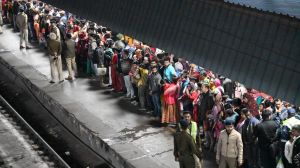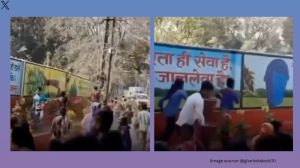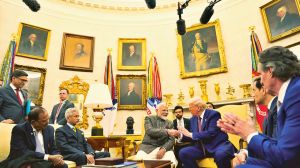UPSC Key: Annual Status of Education Report 2024, DeepSeek and ‘Only two sexes’
Why Greenland’s lakes is relevant to the UPSC exam? What is the significance of topics such as Pradhan Mantri Gramin Aawas Yojana , Railway Budget and Impact of COVID-19 on Education on both the preliminary and main exams? You can learn more by reading the Indian Express UPSC Key for January 29, 2025.
 UPSC Key January, 2025: Here's what you should be reading from the January 29, 2025 edition of The Indian Express
UPSC Key January, 2025: Here's what you should be reading from the January 29, 2025 edition of The Indian Express Important topics and their relevance in UPSC CSE exam for January 29, 2025. If you missed the January 28, 2025 UPSC CSE exam key from the Indian Express, read it here
FRONT PAGE
Sharp gains in reading & math learning levels in schools across states since Covid slump
Syllabus:
Preliminary Examination: Economic and Social Development
Main Examination: General Studies II: Issues relating to development and management of Social Sector/Services relating to Health, Education
What’s the ongoing story: In the first sign of recovery from the slump of the Covid pandemic, reading and arithmetic levels for children between the ages of 6 and 14 years have improved across states, with government schools leading the way.
Key Points to Ponder:
• What is Annual Status of Education Report (ASER)?
• The Annual Status of Education Report (ASER) for 2024—What are key highlights of the report?
• Why Annual Status of Education Report (ASER) findings are important?
• Impact of COVID-19 on Education-Know in detail
• How schools recovered after pandemic?
• What is the surprise leader of this year’s Annual Status of Education Report (ASER)?
• Nipun Bharat Mission and its impact on elementary education?
• What are the Government Initiatives related to education?
• With five years of the 2020 National Education Policy, what has changed for schools?
• What is the need for focusing on Early Childhood Care and Education (ECCE)?
• What did the ASER 2024 survey find about older children (15-16 years)?
Key Takeaways:
• According to the Annual Status of Education Report (ASER) 2024 released on Tuesday, basic reading levels for Class 3 children enrolled in government schools have been the highest since the survey began 20 years ago.
• The number of Class 3 children who can read a Class 2 textbook in government schools stands at 23.4%, up from 16.3% in 2022 and 20.9% in
the pre-pandemic year of 2018.
• Overall reading levels, across both government and private schools, too improved from 20.5% in 2022 to 27.1% in 2024, almost touching the pre-pandemic level of 27.3%.
• Arithmetic levels, too, improved across both government and private schools — from 28.2% Class 3 children who could do at least subtraction in 2018 to 33.7% in 2024, recovering sharply from the slump of 25.9% in 2022.
• The report points out that while almost all states (barring J&K and Nagaland) have shown a recovery in learning levels of Class 3 students when compared to 2022, the year children came back to school after the pandemic, states such as Haryana, Himachal Pradesh, Uttarakhand, Maharashtra, Odisha and Uttar Pradesh showed a 10-percentage point increase in reading levels in 2024 when compared to 2022.
• Other states have also seen big gains when compared to 2018. Bihar saw a jump of almost 8 percentage points in Class 3 reading levels to 20.1% in 2024, while Uttarakhand recorded a sharp rise, from 24.7% in 2018 to 35.6% in 2024. Bihar also saw improvements in Class 3 arithmetic — from 18% in 2018 to 28.2% in 2024.
• But the surprise leader of this pack are the government schools of Uttar Pradesh, where reading levels went up 15 percentage points — from 12.3% in 2018 to 27.9%. Overall, across its government and private schools, reading levels went up from 28.3% in 2018 to 34.4% in 2024. The state’s basic arithmetic levels, too, went up, from 26.9% in 2018 to 40.7% in 2024.
• While there have been improvements in learning levels across age categories, the gains are the highest in the primary sections, which is the focus of learning initiatives of state governments and the Union Education Ministry’s Nipun Bharat Mission, which focuses on foundational literacy and numeracy (FLN).
• The percentage of Class 5 students who can read a Class 2 textbook has gone up from 42.8% in 2022 to 48.7% in 2024, but was yet to reach the 50.4% of 2018.
• The math skills, too, of this cohort have recovered from the pandemic years — from 25.6% in 2022 to 30.7% in 2024, up from the pre-pandemic’s 27.8%.
Do You Know:
• Since 2005, the NGO Pratham has released the Annual Status of Education Report (Rural) to measure basic reading and arithmetic levels among school children, attendance in school and other indicators. The data have revealed broad trends in learning over the years.
• The 2024 survey reached 6,49,491 children in 17,997 villages across 605 rural districts. It recorded major gains in the share of children of the pre-primary age group (3 to 5 years) enrolled in some kind of institution (LKG/UKG/Anganwadi/others). There were substantial increases in reading and arithmetic levels – an encouraging development after the learning losses during the Covid-19 pandemic. This was also the first full-length ASER survey to record digital literacy among older children (15 and 16 years).
• The latest survey, which comes after the smaller Beyond Basics survey of 2023, assessed 6,49,491 children in 605 rural districts on basic reading levels and arithmetic. The survey considered children in three age categories — pre-primary (ages 3 to 5), elementary (6 to 14), and older children (15 to 16).
• The report also shows that government school enrollment, which saw a rise during the pandemic as children moved out of private schools, has almost returned to pre-pandemic levels. The percentage of 6-14-year-olds enrolled in government schools was 65.6% in 2018, rose to 72.9% in 2022, and has now fallen to 66.8%. The overall school enrollment rate among 6-14-year-olds stood at 98.1%, close to the figure of 98.4% in 2022.
• In line with the NEP’s focus on taking early childhood care and education to all children before Class 1, the percentage of children aged between 3 and 5 who enrolled in some form of pre-school rose in 2024 over 2018 and 2022. The sharpest rise was among 5-year-olds — from 58.5% in 2018 to 71.4% in 2024.
• For the first time, ASER also included a section on digital literacy — access, ownership and use of smartphones, and basic digital skills — among 14-16-year-olds. It found that more boys than girls report knowing how to use a smartphone — 85.5% boys compared to 79.4% girls.
Other Important Articles Covering the same topic:
📍ASER 2024: Enrolment up, what’s ahead for early childhood education?
UPSC Previous Year Prelims Question Covering similar theme:
1. Which of the following provisions of the Constitution does India have a bearing on Education? (2012)
1. Directive Principles of State Policy
2. Rural and Urban Local Bodies
3. Fifth Schedule
4. Sixth Schedule
5. Seventh Schedule
Select the correct answer using the codes given below:
(a) 1 and 2 only
(b) 3, 4 and 5 only
(c) 1, 2 and 5 only
(d) 1, 2, 3, 4 and 5
UPSC Previous Year Mains Question Covering similar theme:
📍How have digital initiatives in India contributed to the functioning of the education system in the country? Elaborate on your answer. (2020)
Rs 79,398-cr loan: Rlys wanted it as grant, gets partial relief
Syllabus:
Preliminary Examination: Economic and Social Development
Main Examination: General Studies III: Infrastructure: Energy, Ports, Roads, Airports, Railways etc.
What’s the ongoing story: To ensure its fiscal math doesn’t go awry, the Ministry of Finance has turned down a request by the Ministry of Railways to convert a Rs 79,398 crore ‘special loan’ taken four years ago into a grant.
Key Points to Ponder:
• Why was the Railway Budget merged with the Union Budget?
• Indian Railways is considered the backbone of the country’s economic and transportation network. Analyse its contribution to India’s economy and the challenges it faces.
• The railway sector in India is undergoing rapid modernization. Examine the impact of initiatives like bullet trains, electrification, and privatization on the future of Indian Railways.
• Indian Railways has traditionally been dependent on freight for revenue generation. Suggest measures to diversify its revenue sources while ensuring affordable passenger services.
• What are the key financial and operational challenges faced by Indian Railways? Evaluate the role of Public-Private Partnerships (PPP) in addressing these challenges.
• Analyse the impact of railway budgetary policies on regional development in India.
• Discuss the financial challenges faced by Indian Railways and evaluate the feasibility of granting financial support instead of loans for infrastructure development.
• Indian Railways is often caught between being a commercial enterprise and a social service provider. How does this dual role impact its financial viability? Suggest reforms to improve its sustainability.
Key Takeaways:
• The loan was taken during 2020-21 to manage Covid-related disruptions, and partly to fund the pension liabilities.
• The Railways has instead been given a two-year moratorium just ahead of the loan redemption deadline in the coming financial year 2025-26.
• The Central government extended a special loan to Railways to cover the revenue loss due to the halting of train operations during March-May 2020 after the onset of the pandemic and to shore up its pension fund.
• In its pre-budget consultations with the Finance Ministry, the Railways proposed that the loan be turned into a grant, but eventually, both agreed on a two-year moratorium.
• Budget 2021-22 documents show that a “special loan” of Rs 79,398 crore was extended to the Railways for the “COVID-related resource gap” in 2020-21 to meet the pension expenses of 2019-20. The opening balance of Railways’ pension fund for 2020-21 showed a deficit of Rs 28,398.46 crore.
• In a statement, the Ministry of Railways said, “Indian Railways is performing well. Considering IR (Indian Railways) in the transformation phase of heavy infrastructural development, IR has been granted a moratorium of another two years for financial loan components. However, during the financial years, 2024-26 will pay the interest components of Rs 1,358 crore”.
Do You Know:
• The landmark report of the 2015 expert committee on Railway Reforms, headed by the late economist Bibek Debroy, did clear the decks for a complete overhaul of the national transporter to achieve economic viability in operational terms and recover its loss of competitiveness in the transportation market. While some of the recommendations have been taken on board: including the phasing out of the separate Rail Budget, the redesignation of the Chairman of Railway Board as Chief Executive Officer (CEO) and a plan to accord more powers to General Managers (GMs) and Divisional General Managers (DRMs) to take decisions “independently”, the overarching recommendation on “liberalisation” of Indian Railways has not been taken on board yet.
• The committee dealt with a range of issues related to the Indian Railways from decision-making structure, accounting system, human resource management & employee costs, multiplicity of different channels of entry into the IR, high revenue expenditure and low capital expenditure, financial status to setting up an Independent Regulator etc.
• At the top of the recommendation was liberalisation of Indian Railways. While clarifying that by the term “liberalisation”, it does not mean “privatization”, the committee said that the entry of new operators into railways will be a viable option for encouraging growth and improving services. The committee also said that a regulatory mechanism to promote a healthy competition and to protect the interest of all stakeholders is an essential prerequisite.
• The special loan was provided by the Centre to the Railways contingent to certain repayment conditions linked to its performance metrics. However, it is learnt that the Railways found it difficult to meet the terms and conditions related to certain performance metrics. Following this, the Railways sought a conversion of the loan to a grant in its pre-budget consultations.
• While the Ministry of Railways refused in January to share details of the loan following an RTI query citing these as confidential, the Ministry of Finance in its response said the issue of repayment of the loan by the Ministry of Railways is in “the advance stage of deliberation and is part of the Pre-Budget discussion for the ensuing Budget 2025-26”, and hence “cannot be shared”.
Other Important Articles Covering the same topic:
📍Amrit Bharat 2.0, train to Kashmir, Kavach to be among highlights for Railways in Budget
UPSC Previous Year Prelims Question Covering similar theme:
2. With reference to bio-toilets used by the Indian Railways, consider the following statements: (2015)
1. The decomposition of human waste in the bio toilets is initiated by a fungal inoculum.
2. Ammonia and water vapour are the only end products in this decomposition which are released into the atmosphere.
Which of the statements given above is/are correct?
(a) 1 only
(b) 2 only
(c) Both 1 and 2
(d) Neither 1 nor 2
UPSC Previous Year Mains Question Covering similar theme:
📍Why is Public Private Partnership (PPP) required in infrastructural projects? Examine the role of the PPP model in the redevelopment of Railway Stations in India. (2022)
GOVT & POLITICS
States demand hike in funds under PM rural housing scheme
Syllabus:
Preliminary Examination: Current events of national and international importance
Main Examination: General Studies II: Government policies and interventions for development in various sectors and issues arising out of their design and implementation.
What’s the ongoing story: WITH DAYS FOR Union Budget 2025-26, over a dozen states, mostly BJP-run, have sought a sharp increase in financial assistance for building houses in rural areas under the Pradhan Mantri Awaas Yojana-Gramin (PMAY-G).
Key Points to Ponder:
• What is Pradhan Mantri Awas Yojna Gramin?
• Pradhan Mantri Awas Yojana Gramin (PMAY-G)-Features of the Scheme and Nodal Ministry
• PMAY (Rural or Gramin) and PMAY (Urban)-Difference
• Other Infrastructure and Rural development related schemes-Know them
• Pradhan Mantri Awas Yojana-Gramin (PMAY-G) aims to provide ‘Housing for All’ in rural India—Know its achievements and challenges.
• What is the role of state governments in the implementation of PMAY-G?
• How the demand for increased funding impacts Centre-State relations in rural development programs.
• Rural housing initiatives under PMAY-G are linked with other welfare schemes like MGNREGS and Swachh Bharat Mission—Analyse the benefits and challenges of such convergence.
• Despite large-scale investment in rural housing, housing quality and affordability remain key concerns. What steps can be taken to ensure sustainable and cost-effective housing solutions in rural India?
• The Socio Economic and Caste Census 2011 (SECC) and Pradhan Mantri Awas Yojana Gramin (PMAY-G)-Connect the dots
• How PMAY-G expenditure is shared?
Key Takeaways:
• In a meeting with Union Rural Development Minister Shivraj Singh Chouhan on January 3, sources said the rural development ministers of more than a dozen states sought a hike in PMAY-G unit assistance to Rs 2-2.25 lakh from the existing Rs 1.20-1.30 lakh.
• The list of states which put forth the demand includes: Manipur, Tamil Nadu, Tripura, Madhya Pradesh, Nagaland, Punjab, Bihar, Andhra Pradesh, Assam, Gujarat, Haryana and Jharkhand. While Manipur, Tripura, Madhya Pradesh, Assam, Gujarat and Haryana are run by BJP-led governments, BJP is an ally in the coalition governments in Nagaland, Andhra Pradesh and Bihar. In Tamil Nadu, it’s the DMK-led government and in Punjab, it’s the Aam Aadmi Party government.
• The unit assistance under PMAY-G has not been revised since the inception of the scheme in 2016. In 2016, the government had fixed the PMAY-G unit assistance at Rs 1.20 lakh for plain areas and Rs 1.30 lakh in for hilly states/UTs of J&K and Ladakh, North Eastern States, difficult areas and worst affected Left-Wing Extremism (LWE) districts.
• Before the government brought in the PMAY-G, the unit assistance was Rs 70,000 in plain areas and Rs 75,000 in hilly areas under the erstwhile Indira Awaas Yojana (IAY).
• While the unit assistance provided under the PMAY-G has remained frozen in the last nine years, several states provide higher assistance to beneficiaries from their own funds. For instance, the Jharkhand government provides a unit assistance of Rs 2 lakh per beneficiary under its Abua Awas Yojna’ (AAY). Tamil Nadu, on the other hand, gives a top-up of Rs 1.2 lakh over and above of the Rs 1.2 lakh unit assistance provided under the PMAY-G.
• When PMAY-G was launched in 2016, the government aimed to construct 2.95 crore houses in rural areas.
• Presenting the Interim Budget for 2024-25 on February 1, last year, Union Finance Minister Nirmala Sitharaman, had announced that two crore more houses will be built under the PMAY-G in the next five years. The same target was approved by the Union Cabinet in its first meeting on June 10. When Sitharaman presented a regular budget on July 16, 2024, she allocated Rs 54,500 crore for PMAY-G for financial year 2024-25.
Do You Know:
• Pradhan Mantri Gramin Aawas Yojana is a social welfare programme under the Ministry of Rural Development, Government of India, to provide housing for the rural poor in India. A similar scheme for urban poor was launched in 2015 as Housing for All by 2022. The scheme was officially launched by Prime Minister Narendra Modi on 20 November 2016 from Agra.
• PMAY-G aims at providing a pucca house, with basic amenities, to all houseless householder and those households living in kutcha and dilapidated house, by 2024. The immediate the objective is to cover 1.00 crore household living in kutcha house/dilapidated house in three years from 2016-17 to 2018- 19.
• The minimum size of the house has been increased to 25 sq.mt (from20sq.mt) with a hygienic cooking space. The unit assistance has been increased from Rs. 70,000 to Rs. 1.20 lakh in plain and from Rs75,000 to Rs 1.30 lakh in hilly states, difficult areas and IAP district. The beneficiary is entitled to 90.95 person day of unskilled labour from MGNREGS.
• The cost of unit assistance is to be shared between Central and State Government in the ratio 60:40 in plain areas and 90:10 for North Eastern and the Himalayan States. From the annual budgetary grant for PMAY-G, 90% of funds is to be released to States/UTs for the construction of new house under PMAY-G.
• One of the most important features of PMAY-G is the selection of beneficiary. To ensure that assistance is targeted at those who are genuinely deprived and that the selection is objective and verifiable, PMAY-G instead of selecting a the beneficiary from among the BPL households selects beneficiary using housing deprivation parameters in the Socio Economic and Caste Census (SECC), 2011 date which is to be verified by the Gram Sabhas.
Other Important Articles Covering the same topic:
📍Two crore more rural houses; new scheme to aid ‘deserving’ urban homebuyers
UPSC Previous Year Prelims Question Covering similar theme:
3. As per the NSSO 70th Round “Situation Assessment Survey of Agricultural Households”, consider the following statements: (2018)
1. Rajasthan has the highest percentage share of agricultural households among its rural households.
2. Out of the total agricultural households in the country, a little over 60 percent belong to OBCs.
3. In Kerala, a little over 60 percent of agricultural households reported to have received maximum income from sources other than agricultural activities.
Which of the statements given above is/are correct?
a) 2 and 3 only
b) 2 only
c) 1 and 3 only
d) 1, 2 and 3
THE EDITORIAL PAGE
Syllabus:
Preliminary Examination: Current events of national and international importance.
Main Examination: General Studies II: Effect of policies and politics of developed and developing countries on India’s interests.
What’s the ongoing story: Chintan Chandrachud Writes: On January 20, President Trump signed an executive order announcing that it was the policy of the US government that there were only two sexes, and that those sexes were “not changeable”.
Key Points to Ponder:
• What executive order announcing ‘Only two sexes’ says?
• Discuss the legal and constitutional implications of defining gender strictly as binary in the United States.
• What role do executive orders play in shaping social policies in a democracy? Examine with reference to Donald Trump’s stance on gender identity.
• Analyse the global impact of policies that define gender strictly as male and female.
• How does the recent executive order announcing ‘Only two sexes’ affect human rights and anti-discrimination laws?
• Compare the recognition of gender identity in different countries.
• How does the US policy contrast with the progressive legal frameworks of India, Canada, and Germany?
• What challenges do non-binary and transgender individuals face in countries where gender is legally defined in binary terms? Discuss with examples.
Key Takeaways:
Chintan Chandrachud Writes:
• Although the precise implications of that order are unclear, it brings into focus that debates around gender will be a key legal battleground in the US, the UK and other Western democracies.
• Recent cases in the US and UK offer some clues about what those debates will look like.
—In the US, about half of the states have passed laws prohibiting sex-transition procedures in children. That includes Tennessee, which in 2023 prohibited certain medical interventions for the purpose of allowing children to identify with, or live as, an identity different from their biological sex. —The three prohibited medical interventions were puberty blockers, cross-sex hormones and sex transition surgeries.
—Transgender teenagers and their families, supported by the Joe Biden administration, challenged the Tennessee law claiming that it violated the guarantee of equal protection under the US Constitution. —The Sixth Circuit Court of Appeals upheld the law on the basis that it treated all children alike — no child, whether born male or female, was permitted to receive those medical treatments.
—An appeal to the US Supreme Court was heard in December, and a judgment is expected by the summer.
• Turning to the UK, the regulatory landscape has changed dramatically over the last 12 months. Until early 2024, children with gender dysphoria (who consider that their gender identity is different from their biological sex) were routinely prescribed puberty blockers and cross-sex hormones.
• In April 2024, an independent review concluded that there was not enough evidence to support the safety or effectiveness of puberty blockers to manage gender dysphoria. Its recommendation to prohibit the use of puberty blockers in children was implemented a few months later. That will remain the law until at least 2027, when another review on the subject is scheduled. The administration of cross-sex hormones remains lawful in the UK, albeit subject to strict conditions.
Do You Know:
• Chintan Chandrachud Writes: Three issues arising from these cases are likely to assume significance.
—First, are laws prohibiting medical interventions to address gender dysphoria discriminatory?
—Second, to what extent should the courts become involved in assessing the scientific evidence on which the law is based? Among the major points of debate at the US Supreme Court hearing was whether the Tennessee law should be subjected to a rigorous level of scrutiny.
—The English court was similarly careful to observe that questions of policy on the treatment of gender dysphoria are for the medical profession, not the courts.
—Third, in places where medical treatments for gender dysphoria in children are permitted and a child has consented to treatment, how interventionist should the courts be? The English court concluded that it would only intervene when necessary to protect the child from “grave and irreversible mental or physical harm”. It is easy to imagine other courts reaching a different conclusion.
• US President Donald Trump issued executive orders shortly after he was sworn in to change the US government’s policies on gender and diversity, following through on promises he made on the campaign trail. He rolled back orders from the Biden administration that the Trump White House called “unpopular, inflationary, illegal, and radical practices within every agency and office of the Federal Government”.
• Ammel Sharon Writes: In recent decades, gender has increasingly been viewed as both universal and autonomous. It is universal in that gender seems to appear in all societies, spanning cultures and historical periods. Simultaneously, it is seen as autonomous, existing in a realm of individual choice, with an expanding vocabulary of identities that often seem disconnected from other aspects of social life. However, this understanding has sparked confusion and discomfort for many.
Other Important Articles Covering the same topic:
📍What does Donald Trump mean when he says there are ‘only two genders’?
UPSC Previous Year Prelims Question Covering similar theme:
4. Which Article of the Constitution of India safeguards one’s right to marry the person of one’s choice? (2019)
a) Article 19
b) Article 21
c) Article 25
d) Article 29
ECONOMY
Trump threatens tariffs on India among others that ‘harm’ America
Syllabus:
Preliminary Examination: Current events of national and international importance.
Main Examination: General Studies II: Effect of policies and politics of developed and developing countries on India’s interests.
What’s the ongoing story: US President Donald Trump on Monday said that high-tariff countries such as India, China, and Brazil “harm” America and that Washington would impose taxes on other countries to bring money into the US.
Key Points to Ponder:
• What are tariffs?
• Why tariffs are imposes?
• How are tariffs retaliated?
• Did Trump’s tariffs against China work in the past?
• Discuss the implications of Trump’s tariff threats on global trade dynamics.
• Analyse the impact of protectionist trade policies, such as increased tariffs, on global trade relations.
• How might Trump’s tariff threats affect India-US trade ties?
• What are the key provisions of the US trade laws that allow the President to impose tariffs?
• Discuss the role of the World Trade Organization (WTO) in resolving trade disputes.
• How effective has the WTO been in managing US-China and US-India trade conflicts?
• How can India safeguard its economic interests against protectionist measures imposed by developed nations like the United States?
Key Takeaways:
• “We’re going to put tariffs on outside countries and outside people that really mean harm to us. Well, they mean us harm, but they basically want to make their country good,” Trump told House Republicans at a Florida retreat on Monday, PTI reported.
• “Look at what others do. China is a tremendous tariff maker, and India and Brazil and so many other countries. So we’re not going to let that happen any longer because we’re going to put America first,” he said.
• Trump is reported to have said that the US will establish a “very fair system where money is going to come into our coffers, and America is going to be very rich again,” adding that it will happen “very quickly”.
• Trump said that it was time for the US to return to the system that made it “richer and more powerful than ever before.”
• “If you want to stop paying the taxes or the tariffs, you have to build your plant right here in America. That’s what’s going to happen
at record levels. We’re going to have more plants built in the next short period of time than anybody ever envisioned before because the incentive is going to be there, as they will have no tariffs whatsoever,” he said.
Do You Know:
• The US is India’s largest trade partner, with bilateral trade reaching almost $120 billion in FY24 — slightly higher than India’s trade with China. However, unlike China, India’s trade relationship with the US is favourable, making the US a vital source of foreign exchange.
• Despite attempts to diversify exports, India’s dependence on the US has grown over the past decade. According to official 2022–23 data, the US accounts for 18% of India’s exports, compared to 10% in 2010–11. India’s export basket to the US is well-diversified, benefiting
industries ranging from textiles to electronics and engineering.
• The Indian Express reported that India’s commerce and industry ministry has begun inter-ministerial talks to better prepare for likely changes in US trade policy that could involve tariffs on Indian goods exports to the US under the new Donald Trump administration.
• This comes a day after Trump instructed his commerce and treasury departments to investigate the causes of America’s “large and persistent” annual trade deficits in goods and announced a new ‘External Revenue Service (ERS)’ to collect tariffs from foreign governments.
Other Important Articles Covering the same topic:
📍Behind Colombia’s U-turn on US deportations: Trump’s tariff threats and a trade imbalance
UPSC Previous Year Prelims Question Covering similar theme:
5. What is a tariff in international trade?
(a) A subsidy given to domestic producers
(b) A tax imposed on imported goods
(c) A financial penalty imposed on exporters
(d) A trade agreement between two countries
EXPLAINED
Syllabus:
Preliminary Examination: Current events of national and international importance.
Main Examination: General Studies III: Science and Technology- developments and their applications and effects in everyday life.
What’s the ongoing story: On Monday, the stock market opened with a massive dip, especially the tech-heavy Nasdaq, which dropped by about 3 per cent. This is its worst performance in the last two years. This drop has been attributed to the meteoric rise of Chinese AI startup DeepSeek, which has in the last few weeks grabbed global attention after it unveiled its AI models — DeepSeek-V3 and DeepSeek-R1, a reasoning model.
Key Points to Ponder:
• What is DeepSeek?
• What sets DeepSeek models apart
• What is different about DeepSeek AI models?
• Discuss the significance of Deepseek and other open-source AI models in democratizing artificial intelligence.
• Evaluate the need for regulatory frameworks in the context of open-source AI like Deepseek.
• The rise of open-source AI challenges the monopoly of Big Tech corporations. Analyse the implications of this trend on global technology governance.
• Examine the ethical and security challenges associated with open-source AI models.
Key Takeaways:
• Owing to its optimal use of scarce resources, DeepSeek has been pitted against US AI powerhouse OpenAI, as it is widely known for building large language models. DeepSeek-V3, one of the first models unveiled by the company, earlier this month surpassed GPT-4o and Claude 3.5 Sonnet in numerous benchmarks.
• DeepSeek-V3 stands out because of its architecture, known as Mixture-of-Experts (MOE).
• The MOE models are like a team of specialist models working together to answer a question, instead of a single big model managing everything.
• The DeepSeek-V3 model is trained on 14.8 trillion tokens, which includes large, high-quality datasets that offer the model greater understanding of language and task-specific capabilities.
• Additionally, the model uses a new technique known as Multi-Head Latent Attention (MLA) to enhance efficiency and cut costs of training and deployment, allowing it to compete with some of the most advanced models of the day.
• Even as the AI community was marveling at the DeepSeek-V3, the Chinese company launched its new model, DeepSeek-R1. The new model comes with the ability to think, a capability that is also known as test-time compute. The R1 model has the same MOE architecture, and it matches, and often surpasses, the performance of the OpenAI frontier model in tasks like math, coding, and general knowledge. R1 is reportedly 90-95 per cent more affordable than OpenAI-o1.
• The R1, an open-sourced model, is powerful and free. While O1 is a thinking model that takes time to mull over prompts to produce the most appropriate responses, one can see R1’s thinking in action, meaning the model, while producing the output to the prompt, also shows its chain of thought.
• R1 arrives at a time when industry giants are pumping billions into AI infrastructure. DeepSeek has essentially delivered a state-of-the-art model that is competitive. Moreover, the company has invited others to replicate their work by making it open-source.
• The release of R1 raises serious questions about whether such massive expenditures are necessary and has led to intense scrutiny of the industry’s current approach.
Do You Know:
• DeepSeek is a Chinese AI company based out of Hangzhou founded by entrepreneur Liang Wenfeng. He is also the CEO of quantitative hedge fund High Flyer. Wenfeng reportedly began working on AI in 2019 with his company, High Flyer AI, dedicated to research in this domain. DeepSeek has Wenfeng as its controlling shareholder, and according to a Reuters report, HighFlyer owns patents related to chip clusters that are used for training AI models.
• What sets DeepSeek models apart is their performance and open-sourced nature with open weights, which essentially allows anyone to build on top of them. The DeepSeek-V3 has been trained on a meager $5 million, which is a fraction of the hundreds of millions pumped in by OpenAI, Meta, Google, etc., into their frontier models.
Other Important Articles Covering the same topic:
📍DeepSeek’s Sputnik moment: Five ways in which US-China AI race plays out for India
📍Top US AI developers, companies rush to analyse DeepSeek low-cost models
UPSC Previous Year Prelims Question Covering similar theme:
6.With the present state of development, Artificial Intelligence can effectively do which of the following?
1. Bring down electricity consumption in industrial units
2. Create meaningful short stories and songs
3. Disease diagnosis
4. Text-to-Speech Conversion
5. Wireless transmission of electrical energy
Select the correct answer using the code given below:
a) 1, 2, 3 and 5 only
b) 1, 3 and 4 only
c) 2, 4 and 5 only
d) 1, 2, 3, 4 and 5
WHY GREENLAND’S CRYSTAL BLUE LAKES HAVE TURNED BROWN
Syllabus:
Preliminary Examination: Current events of national and international importance.
Main Examination: General Studies III: Conservation, environmental pollution and degradation, environmental impact assessment.
What’s the ongoing story: More than 7,500 lakes in western Greenland have turned brown, begun emitting carbon, and suffered a drop in water quality due to extreme weather events that took place in 2022, according to a new study.
Key Points to Ponder:
• Explain the significance of Greenland’s ice sheet in regulating global climate patterns.
• How does its melting impact sea levels and weather systems?
• Discuss the reasons behind the browning of Greenland’s lakes.
• What does this phenomenon indicate about the ongoing climate change crisis?
• How do Arctic and Antarctic climate changes differ in terms of their causes and consequences?
Key Takeaways:
• These lakes, which were once crystal blue, provide drinking water to locals, feature rich biodiversity, and sequester atmospheric carbon.
• The study, ‘Abrupt transformation of west Greenland lakes following compound climate extremes associated with atmospheric rivers’, was published in the journal Proceedings of the National Academy of Sciences last week.
• The analysis also revealed that the lakes underwent the transformation at a breakneck speed. Typically, such changes take place over centuries, but in this case, they happened within months after the extreme weather events occurred.
• Jasmine Saros, a professor at the University of Maine (United States) and lead author of the study, told Earth.com, “The magnitude of this [change in the lakes] and the rate of change were unprecedented.”
• As organic carbon and other elements washed into the lakes, their physical, chemical, and biological properties changed. The study said that the impact of the 2022 extreme weather events was visible by July 2023, meaning the lakes’ colour, odour, and taste had dramatically altered.
• The findings have come just three months after a different study revealed that the amount of carbon absorbed by land has temporarily collapsed. It had concluded that forest, plants and soil – as a net category – absorbed removed only 0.23 to 0.65 gigatonnes of carbon in 2023. This was the lowest amount since 2003 and more than three times lower than the average over the past decade.
Do You Know:
• Greenland usually experiences snowfall during the fall season, from late August to late September. However, in 2022, due to warmer temperatures, the snow turned into rain. The heat also caused permafrost — frozen ground that often contains a significant amount of organic carbon — to thaw, leading to the release of carbon, iron, magnesium, and other elements. As the record level of rain poured on the region, these elements were washed into the lakes, resulting in their transformation.
• According to the study, the increase in temperatures and precipitation was driven by several atmospheric rivers. The National Oceanic and Atmospheric Administration (NOAA) defines atmospheric rivers as: “Relatively long, narrow regions in the atmosphere — like rivers in the sky — that transport most of the water vapour outside of the tropics”.
• Although these “rivers in the sky” bring much-needed precipitation and contribute to annual freshwater supplies, strong atmospheric rivers can lead to disastrous flooding and bring in heat. Studies have shown that with rising global temperatures, atmospheric rivers are expected to become more intense — they will be significantly longer and wider than the ones we observe today, according to a 2018 study by the National Aeronautics and Space Administration (NASA).
• Existing climate models show that by the end of the 21st century, atmospheric rivers will become 50–290% more frequent in Greenland, western North America, east Asia, western Europe and Antarctica, a report by Phys.com said.
Other Important Articles Covering the same topic:
📍Greenland glaciers lost more ice than previously estimated, says NASA study
UPSC Prelims Practice Question Covering similar theme:
7. Which of the following is the primary reason for Greenland’s lakes turning brown?
(a) Increased volcanic activity under the ice
(b) Rising temperatures causing sediment and organic matter release
(c) Pollution from industrial waste in the Arctic region
(d) Increased salinity due to ocean water intrusion
|
PRELIMS ANSWER KEY |
| 1. (d) 2. (d) 3. (c) 4.(b) 5.(b) 6.(d) 7.(b) |
For any queries and feedback, contact priya.shukla@indianexpress.com
Subscribe to our UPSC newsletter. Stay updated with the latest UPSC articles by joining our Telegram channel – IndianExpress UPSC Hub, and follow us on Instagram and X.
Feb 17: Latest News
- 01
- 02
- 03
- 04
- 05





































